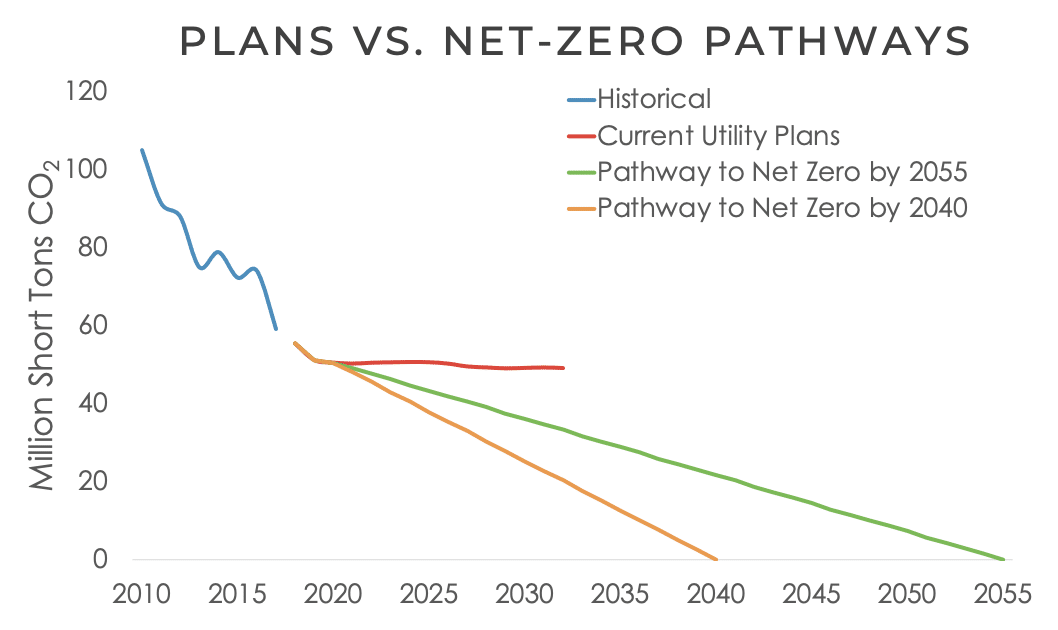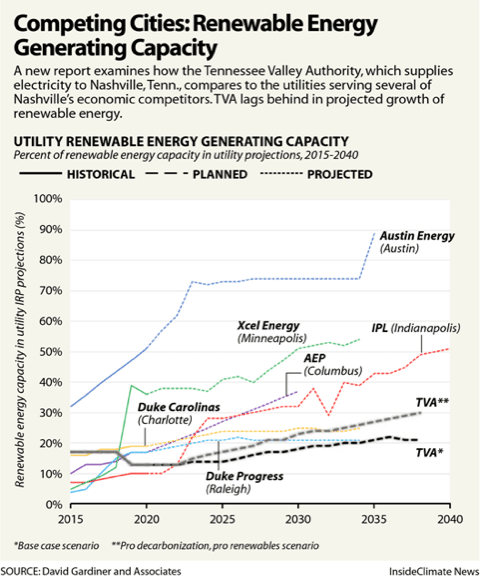SACE tracks carbon emissions and planned generation in its annual report entitled "Tracking Decarbonization in the Southeast" to answer the question of whether or not the power sector is decarbonizing at a rate adequate enough to mitigate the climate crisis. In this blog, we share information and context from the report related to TVA compared to other large utilities in the region.
Maggie Shober and Heather Pohnan | October 9, 2020 | Alabama, Climate Change, Energy Policy, Tennessee, UtilitiesThe next electric utility in our decarbonization series is the Tennessee Valley Authority (TVA), which is notable for being the nation’s largest public utility. Created in 1933, TVA originally brought innovation to the Tennessee Valley by electrifying parts of the country that previously had little or no access to electricity. Unfortunately for TVA customers who want cleaner air, water, and energy, this innovation does not extend to decarbonization. TVA has not established a meaningful decarbonization goal, and carbon emission reductions will remain small beyond the early 2020s under TVA’s current plans.

TVA stands in contrast to peer utilities like Duke and Southern that have both announced net-zero goals to reduce total emissions. One of the unifying traits of many utility carbon goals is that they include long-term reductions targets by 2050, and have begun taking steps to meet them, such as researching net-zero pathways in resource planning proceedings. While TVA has publicized an expected reduction in its emissions rate (but not total emissions) of 80% from 2005 levels, its analysis is limited to the 2030 to 2035 timeframe and does not constitute a formal goal or plan.
Download the Report
Read the Report Series
Watch the Webinar
Cities taking lead could have uphill path to decarbonization
TVA is composed of over 150 electricity distributors, also known as local power companies (LPCs). These LPCs often serve specific municipalities or cities, which is significant because many cities are taking decarbonization in their own hands. This is also true in the Tennessee Valley, where cities like Knoxville and Nashville have sent a strong message to TVA by enacting their own climate-related goals. However, TVA’s disinterest in actively formulating plans to decarbonize makes it unclear if it is unable or unwilling to hear that message.
What does this mean for Nashville?
A recent report from consulting firm David Gardiner and Associates (DGA) also found that TVA’s future plans lead to a flatlining of carbon emissions. The DGA report then compared TVA’s future emissions trajectory and proportion of renewable energy to cities that compete with Nashville for attracting new businesses: Raleigh, North Carolina; Charlotte, North Carolina; Austin, Texas; Columbus, Ohio; and Minneapolis, Minnesota. DGA found Nashville would likely have trouble attracting businesses in the future because it is a captured customer of TVA, and TVA’s decarbonization trajectory does not match with goals in the business community.
“Climate change threatens the well-being of my kids and grandkids as well as much of humanity,” Gary Garfield, a retired Bridgestone Americas CEO who is among the report’s 20 backers, told Inside Climate News. “It is my hope that this project will prompt TVA to be considerably more aggressive in reducing its greenhouse gas emissions, either of its own accord or because of pressure from those it serves.”

Michael Vandenbergh, a Vanderbilt University law professor, told Inside Climate News’ Jim Bruggers that while the report is focused on Nashville, “it has similar implications for Knoxville, Chattanooga, Memphis, and the other cities in the TVA service area.” This is something we will be watching as we engage as a member of the Mayor’s Climate Council in Knoxville.
What does this mean for Memphis?
Memphis is home to the largest utility in Tennessee by demand: Memphis Light, Gas, & Water (MLGW). MLGW is in the midst of deciding whether to switch power providers and leave TVA. MLGW completed an integrated resource plan (IRP) earlier this year that showed that the city could save money and lower emissions by increasing energy efficiency and using a combination of renewable and fossil generation instead of continuing with TVA as its sole power provider.
If Memphis decides to leave TVA for cleaner and cheaper energy options, it has the potential to significantly change the way TVA operates its generation resources to meet the needs of its remaining customers. Maybe that is the wake-up call TVA needs to set forth on a true decarbonization pathway.
Decarbonization at TVA could be an engine out of crisis
From TVA’s beginnings as a part of FDR’s New Deal, it was a proof of concept that delivery of inexpensive and clean power is possible, and is an engine for job creation and economic development during a time where government-led mobilization is needed. An aggressive decarbonization strategy by the nation’s largest public power utility would do wonders to jumpstart recovery from the conglomerate of crises we face today: the existential threat of climate catastrophe; the long-brewing crisis of energy affordability; and the recent sharp economic downturn as a result of COVID-19.
Download the Report
Read the Report Series
Watch the Webinar
#SEEmissionsReport2020